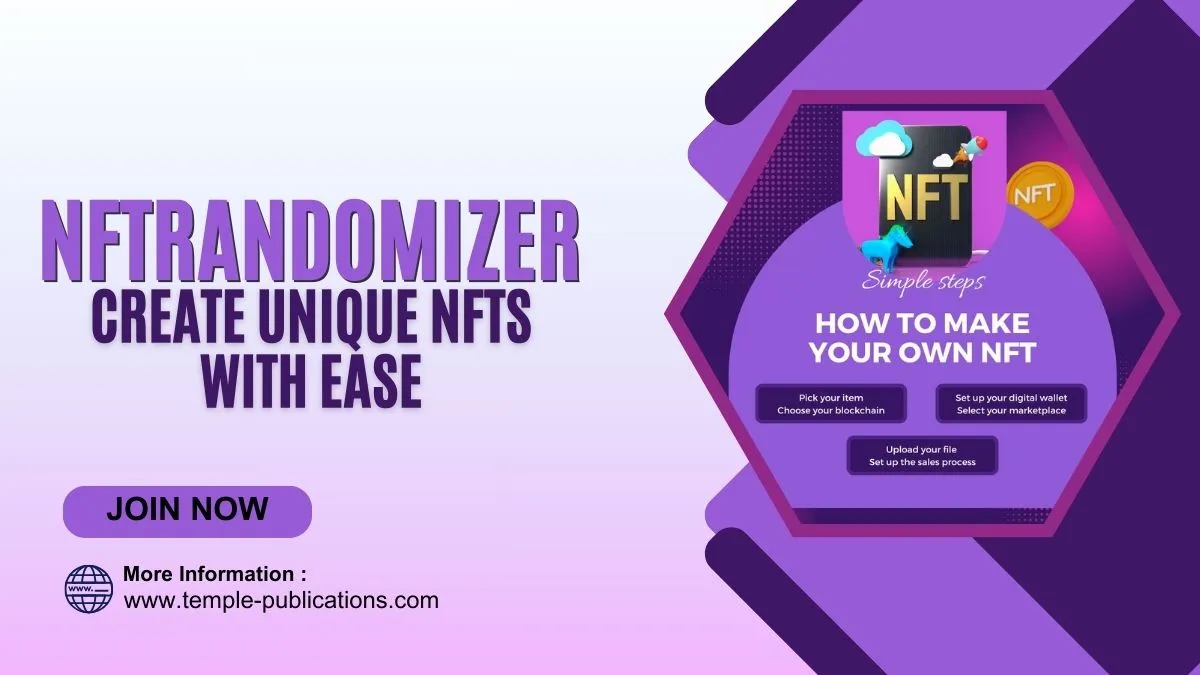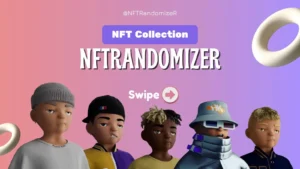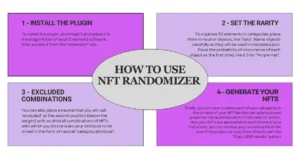GENERAL
NFTRandomize: Elevate Your Cinema4D NFTs

NFTRandomize is a powerful plugin designed specifically for Cinema4D, enabling digital artists to create unique NFTs with ease. Developed to cater to the growing demand for personalized and rare digital assets, NFTRandomize allows users to generate NFTs with randomized combinations of attributes. By integrating rarity levels and using a JSON metadata file, the plugin simplifies the complex process of NFT creation and minting.
Key Features of NFTRandomize
- Easy Randomization of Attributes: it automates the process of creating randomized attribute combinations, making it easier for artists to produce diverse and unique NFTs.
- Customization of Attribute Rarity Levels: Artists can set specific weights and probabilities for different attributes, allowing them to introduce rarity and value into their NFTs.
- JSON Metadata File: The plugin uses a JSON metadata file to streamline the minting process. This approach reduces guesswork and saves time by providing a structured format for NFT data.
- Support for Various Cinema4D Versions: NFTRandomize is compatible with multiple versions of Cinema4D, ensuring that artists can integrate the plugin into their existing workflows regardless of their software version.
How NFTRandomize Enhances NFT Creation
NFTRandomize revolutionizes NFT creation by providing an easy way to randomize attributes and set rarity levels. By automating the generation of unique attribute combinations, the plugin eliminates the manual effort typically involved in creating NFTs. The ability to assign weights and probabilities to attributes allows artists to introduce scarcity and exclusivity, making each NFT stand out in the crowded marketplace. Additionally, the use of a JSON metadata file simplifies the minting process, ensuring that NFTs are correctly formatted and ready for sale.

Compatibility and Support
NFTRandomize supports a range of Cinema4D versions, from older releases to the latest updates. The installation process is straightforward, involving the addition of the plugin to Cinema4D’s plugin directory. For users encountering compatibility issues, the tool provides troubleshooting guides and support resources to resolve common problems. The plugin’s compatibility ensures that artists can seamlessly integrate it into their existing projects.
Working with Attributes
Attributes are essential elements in NFTs, representing various characteristics such as visual elements, themes, or functionalities. NFTRandomize allows users to define and customize these attributes, creating diverse and engaging NFTs. Artists can experiment with different combinations to achieve unique results. For example, an artist might randomize attributes like color schemes, textures, or accessories to produce a range of NFT variations.
Setting Rarity Levels
Authenticity is a key part of why NFTs are valuable as they are rare. NFTRandomize allows artists to proactively regulate rarity levels as it allows them to set the weights and the possibility of distinct traits. For example, colors and texture, which are rarely present on the fabric, would be assigned a lesser probability — thus making it even more desirable. This feature works in enhancing the possibility of creating NFTs with different levels of scarcity thus appealing to the collectors and increasing the overall worth of art.
JSON Metadata File
The JSON metadata file plays a vital role in the NFT minting process. NFTRandomize generates this file to organize and structure the data associated with each NFT. The JSON format ensures that essential information, such as attribute details and rarity levels, is accurately represented. This structured approach simplifies the minting process, reducing errors and ensuring that NFTs are correctly formatted for sale on various platforms.
Integration with Cinema4D
NFTRandomize integrates seamlessly with Cinema4D, a leading software for 3D design and animation. The plugin enhances Cinema4D’s capabilities by adding tools for randomizing attributes and managing rarity levels. Artists can leverage its features within their existing Cinema4D projects, streamlining the process of creating and minting NFTs.
User Interface and Experience
NFTRandomize features a user-friendly interface designed to make NFT creation accessible to artists of all levels. The interface provides intuitive tools for setting attributes, and rarity levels, and generating JSON metadata. User feedback indicates that the plugin’s design simplifies the NFT creation process and enhances the overall user experience.
Creating NFTs with NFTRandomize
- Install and Configure the Plugin: Add NFTRandomize to Cinema4D and configure the plugin settings.
- Define Attributes: Set the attributes and their respective values.
- Set Rarity Levels: Assign weights and probabilities to attributes to determine their rarity.
- Generate NFTs: Use NFTRandomize to produce randomized attribute combinations.
- Mint NFTs: Export the JSON metadata file and mint the NFTs on a suitable platform.

Minting NFTs
Minting entails the creation of a token for the NFT and storing of data about the NFT on a specific blockchain. While the creation of such lists is rather complex, NFTRandomize automatically creates the corresponding JSON metadata file which is required to create a given NFT on many platforms. Some of the preferred platforms where artists can list their art and sell them include popular nude token marketplaces.
Getting Help and Support
NFTRandomize offers a range of support resources, including documentation, forums, and customer service. Users can access troubleshooting guides and seek assistance for technical issues. The plugin’s active community and developer support ensure that artists receive the help they need.
Impact on the NFT Marketplace
It has a significant impact on the NFT marketplace by enabling the creation of unique and valuable digital assets. The plugin’s ability to automate attribute randomization and simplify minting contributes to a more dynamic and competitive NFT market. As the demand for NFTs continues to grow, tools like NFTRandomize play a crucial role in shaping the future of digital art.
Future Developments and Updates
NFTRandomize continues to evolve, with ongoing developments aimed at improving functionality and user experience. Future updates may include new features, enhanced compatibility, and additional support for emerging NFT standards. The plugin’s developers actively engage with the community to gather feedback and address user needs.
Conclusion
NFTRandomize is a state-of-the-art plugin for the Cinema4D platform that provides the artist with the powerful utility to create NFTs. Because it makes attribute randomization automatic, establishes rarity levels, and makes the minting process more straightforward, it improves the NFT generation process and is a part of the progressing digital art world. As observed from the above discussions, the NFT market is increasingly becoming an important asset for artists who wish to develop unique and valuable experiences in the market.
Did you find this article helpful? Check out the rest of our blog now!
-

 BIOGRAPHY7 months ago
BIOGRAPHY7 months agoBehind the Scenes with Sandra Orlow: An Exclusive Interview
-

 HOME1 year ago
HOME1 year agoDiscovering Insights: A Deep Dive into the //vital-mag.net blog
-

 HOME1 year ago
HOME1 year agoSifangds in Action: Real-Life Applications and Success Stories
-

 BIOGRAPHY1 year ago
BIOGRAPHY1 year agoThe Woman Behind the Comedian: Meet Andrew Santino Wife




























